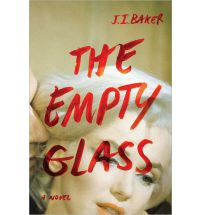Arthur Miller once said, To understand Marilyn [Monroe] best, you have to see her around children. They love her; her whole approach to life has their kind of simplicity and directness.
Jim Baker (writing as JI Baker), author of the recently released The Empty Glass, a novel that examines the circumstances around Monroe's death, agrees with this sentiment. He believes that it's this childlike ingenue in incongruous combination with Monroe's status as a sex symbol that's contributed to her enduring appeal to the public.
'Part of Monroes continued appeal lies in this very thing,' says Jim. 'She embodied a number of opposites. For instance, she spent most of her life feeling betrayed by men, and yet she herself betrayed men. '
He notes that Monroe left her first husband, and also cheated on Arthur Miller with her Let's Make Love co-star Yves Montand.
'Her screen schtick was that of a naive, childlike woman totally unaware of her erotic charms. But in real life she knew exactly the kind of power she had in this regard.
Jim adds that he can't think of another screen siren who embodied both innocence and very powerful sexuality in such a way.
'It was a new thing. She invented it, and it clearly struck a chord with people.'
Indeed, Miller once wrote: 'She was'all paradox and enticing mystery, street-tough one moment, then lifted by a lyrical and poetic sensitivity that few retain past early adolescence.'
Unsurprisingly, the mystery of Monroe has spurred a number of biographies, in both print and visual formats, but Jim's book takes an interesting position on her death: its a noir-inspired whodunnit.
'Originally, I was only interested in the discovery of a diary that contained secrets that might somehow threaten the person who discovered it,' he says.
Though Jim initially had no idea where the story was going, he recalled along the way a legend about Marilyn Monroe having Kept a secret diary filled with government secrets and things she might have known about the Kennedy brothers.
'So I wondered: What would happen if my diary was Marilyns? Well, once I pursued that, the whole story opened up, as I was able to mix heavily researched fact with fiction. I have a background as a journalist, so I like to think that this played to my strengths.'
Though Monroe's life and death may seem a story that's familiar to the general public, Jim was surprised to find out just how little people truly know about Monroe's story.
'I think I rose to the challenge, in part, because much of the story is actually not that familiar to the general public. I have received many emails and reviews from people who were unaware that some of the seemingly wild conspiracy theories surrounding Monroes death are based in fact.'
In writing about such a well-known and beloved figure, Jim was also all too aware that he might be setting himself up for a potential backlash.
'Several people have accused me of exploiting a dead woman whod lived an often sad life: Why not let her rest in peace? I understand this perspective, but I would respectfully suggest that any given cultures mythology is part of the toolbox that a writer works with,' he says.
'Writers should have the freedom to invent or reimagine the details of any mythic or historical life, I believe.'
Writers from all ages and eras have drawn on famous stories and myths for use in their work, he says. Doing so can even help preserve these individuals' legacies.
'Marilyn Monroe, Elvis, James Dean, the Kennedys: They have all become somehow more than people'more than history, even'and to say that a writer cant use these myths is, I think, ridiculous.'
Even Shakespeare got in on the act.
'God knows I am not comparing myself to Shakespeare,' he says, 'but his Richard the III is not the historical Richard the III.'
That said, Jim has stuck firmly to the facts when it comes to Marilyn and her death in the book:'In my case it was' important for me to get the historical details right, he says.
Or at least as accurate as possible given the many conflicting stories. There are, for instance, at least four versions of the time frame surrounding her death, which may have occurred on the night of August 4 or the early-morning hours of August 5.
These varying accounts were part of the reason that Jim wanted to create a 'streamlined narrative' of the events surrounding Monroe's death.
'People who read it might be as shocked as I was that it was all 'real',' he says.
That said, the line between fact and fiction isnt always easily drawnand thats part of what drew Jim to telling Monroes story in this particular manner.
'The books narrator isnt always telling the truth, so the ever-shifting nature of the fiction mingles with the hard-to-believe nature of the fact,' he says. 'Real life seems like fiction, and maybe fiction seems like real life.'
Purchase'The Empty Glass from
Amazon | Book Depository UK | Book Depository USA | Booktopia | The Nile
Visit Jim Bakers website | Twitter
















